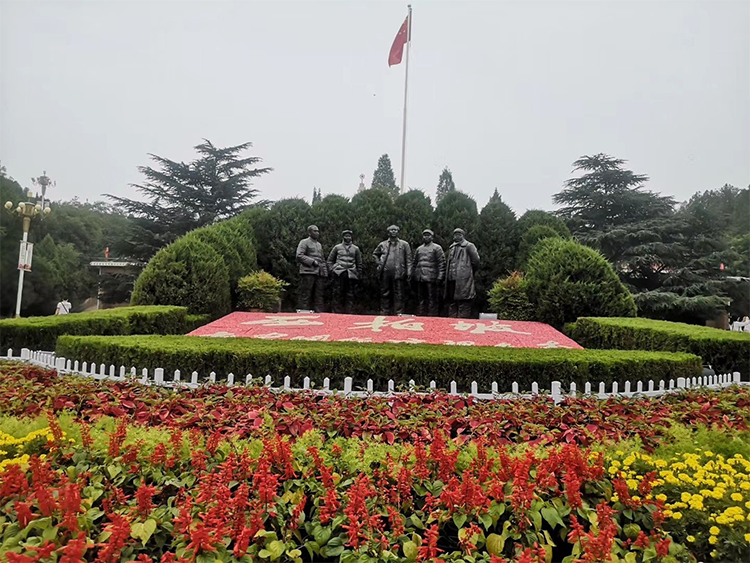Red Tourism in China: Explore Xibaipo, the Cradle of New China
Dawn lifts from the Taihang foothills and the mist parts to reveal a cluster of humble earthen courtyards. There are no ornate palaces here—only simple adobe houses that witnessed decisions that reshaped modern China. Xibaipo, a small mountain village that served as the Communist Party’s “final rural headquarters” in the late civil war, was where Mao issued the telegrams that directed three decisive campaigns and where Zhou Enlai drafted foundational documents for the new state. Today the site preserves that plain, weighty atmosphere: worn millstones, yellowed telegraph drafts, and low command rooms—every detail quietly testifies that “New China began here.”
1. Core highlights: China’s revolutionary turning point
Xibaipo’s significance lies in its role as one of modern China’s most strategic decision centers. From May 1948 to March 1949, leaders including Mao Zedong, Zhu De and Zhou Enlai planned campaigns under austere conditions—what they called “millet and rifles”—and won the Liaoshen, Huaihai and Pingjin campaigns that paved the way for the People’s Republic of China. The famous exhortation from the Second Plenary Session of the Seventh Central Committee—calling for comrades to remain humble, cautious, and hardworking—was formulated here and remains a core Party principle.
Unique selling points:
– Historical status as the “birthplace of New China”: the turning point from revolutionary victory to state-building.
– Authentic immersion: original adobe buildings and preserved command rooms create a 1949 atmosphere.
– Red education combined with scenic countryside: the Taihang foothills offer pastoral views alongside revolutionary heritage—ideal for cultural immersion and eco-friendly exploration.
2. Historical depth: the “national brain” inside earthen houses
Every room in Xibaipo holds dramatic stories. The Central Committee Former Site is the heart of the attraction and includes Mao’s old residence, the Military Commission command room, and the assembly hall for the Second Plenary Session. These yellow-earth houses are sparsely furnished—a wooden table, an oil lamp, a military map—but they were the nerve center from which large-scale operations were commanded.
Not-to-miss details:
– Military Commission command room: a compact space under 60 square meters where battle maps with red and blue pencil markings show tactics for the three campaigns.
– Mao’s residence: the desk still holds the inkstone he used when writing “Carry the Revolution Through”; a pear tree he planted blooms white in spring.
– Air-raid shelter remains: dug to avoid Kuomintang air attacks, these relics show the perilous conditions and the ingenuity of revolutionaries.

3. Tour tips: how to experience the red classics efficiently
Recommended route (half-day highlights):
1. Xibaipo Memorial Hall (about 1 hour): Over a thousand artifacts, photos, and a dynamic diorama explain the Central Committee’s time here.
2. Central Committee Former Site (about 1.5 hours): Visit Mao’s residence, Zhou Enlai’s quarters, and the military command room to feel the “war-time office.”
3. Monument Square (about 30 minutes): Pose at the “Exam” sculpture that symbolizes the revolutionary spirit of “rushing to Beijing to take the exam.”
Deep-experience suggestions:
– Taihang hikes: Trails behind the site lead to a midway lookout with sweeping views of the Hutuo River and village—see the revolution’s cradle set in landscape.
– Guided narration: The memorial offers Chinese and English audio guides (rental ¥20) and you can request an expert guide by appointment (book at least one day in advance).
4. Practical information: transport, tickets and seasonal tips
Location: Pingshan County, Shijiazhuang, Hebei Province — about 90 km from Shijiazhuang city center.
Getting there:
– By car: Take the Jingkun (G5) Expressway and exit for Xibaipo; about 1.5 hours from Shijiazhuang.
– By public transport: Take the tourist shuttle from Shijiazhuang North Station (about ¥25, roughly 2 hours).
Tickets and opening hours:
– Free admission (ticket exchange requires valid ID; foreign visitors should present passports). Memorial closed on Mondays.
– Peak season (Apr–Oct): 08:30–17:30; off-season until 17:00.
Best time to visit: Spring and autumn (April–May for blossoms, September–October for colorful foliage). Summer requires sun protection and winter may close some outdoor exhibits.

5. Immersive experiences: food, lodging and red memories
Food:
– Site canteen: try the “Xibaipo set” of millet porridge, steamed corn buns, and pickles to taste the simple revolutionary diet.
– Local farmhouse cuisine: recommended Hutuo River fish feasts and Taihang mushroom stews with free-range chicken.
Where to stay:
– Xibaipo Hotel: walking distance to the site; standard rooms around ¥300 per night, usually including breakfast.
– Local guesthouses: Pingshan county farm stays offer traditional kang beds and a homely experience (¥100–150 per night).

Conclusion: a journey across time
Xibaipo is more than a memorial—it’s a three-dimensional history book. Touch bullet-marked wooden doors, imagine the clack of telegraph machines, and feel the gravity behind the phrase that taking national victory was only the first step of a much longer march. Whether you’re a history buff, a family traveler, or a cultural seeker, Xibaipo offers authenticity and depth that reveal one of China’s most dramatic chapters.
Set out now—the red sanctuary beneath the Taihang Mountains awaits your footsteps and reflection.


